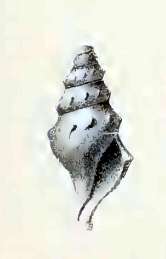Spirotropis phaeacra
| Spirotropis phaeacra | |
|---|---|
 | |
| Original image of a shell of Spirotropis phaeacra | |
| Scientific classification | |
| Kingdom: | Animalia |
| Phylum: | Mollusca |
| Class: | Gastropoda |
| Clade: | Caenogastropoda |
| Clade: | Hypsogastropoda |
| Clade: | Neogastropoda |
| Superfamily: | Conoidea |
| Family: | Drilliidae |
| Genus: | Spirotropis |
| Species: | S. phaeacra |
| Binomial name | |
| Spirotropis phaeacra (Watson, 1881) [1] | |
| Synonyms[2] | |
| |
Spirotropis phaeacra is a species of sea snail, a marine gastropod mollusk in the family Drilliidae.[2]
Description
The shell of this micromollusc grows to a length of 4.6 mm.
(Original description) The conical, angulated, tubercled shell is thin, polished, glassy, with a blunt, dun apex, a contracted base, and a longish columella. There is no longitudinal sculpture other than the fine scratch-like lines of growth. Toward the bottom of each whorl is a row of about twelve round, blunt-tipped, rather prominent tubercles, which form an angulated keel where otherwise there is no carination. There is also a slight blunt keel round the base. Its surface is covered with very obsolete, rounded, flat threads. The colour of the shell is polished glassy white, with a hyaline dun apex. The spire is high, rather narrow, and conical. Its profile-lines are little interrupted by the carinal tubercles. The protoconch conists of about two glossy, dun-coloured, globose, embryonic whorls. The extreme tip is rounded and slightly bent down on one side. The shell contains 6 short whorls of slow growth, with a longish, drooping, somewhat concave shoulder, angulated below the middle by the row of tubercles, and slightly contracted into the inferior suture. The base, which is a good deal contracted, is conical, and runs out into a fine longish snout. The aperture is club-shaped, being somewhat pointedly rhomboidal above, with a longish siphonal canal below. The outer lip is thin, with a pretty regular convex curve, which is flattened at the summit, and prolonged in a straightish line at the siphonal canal. On leaving the body it retreats at once, leaving a very small shelf above the sinus, which is shaped like an open U with diverging margins: toward the lower part of the aperture the lip runs out in a pinion-shaped projection, retreating thence to the point of the columella. The inner lip is thin and narrow,a little concave, with a loug sharp-edged truncation of the point of the columella. [3]
Distribution
This species occurs in the Atlantic Ocean off Northeast Brazil at a depth of 630 m.
References
- ↑ Watson, R.B. (1881) Mollusca of H.M.S. Challenger Expedition. Parts VIII-X. Journal of the Linnean Society (London), 15, 388–475.
- 1 2 Spirotropis phaeacra (Watson, 1881). Retrieved through: World Register of Marine Species on 10 November 2011.
- ↑ Watson, R.B. (1886) Report on the Scaphopoda and Gasteropoda collected by the H. M. S. Challenger during the years 1873–76. Report on the Scientific Results of the Voyage of the ‘Challenger’ (Zoology), 15, 1–756, 50 pls